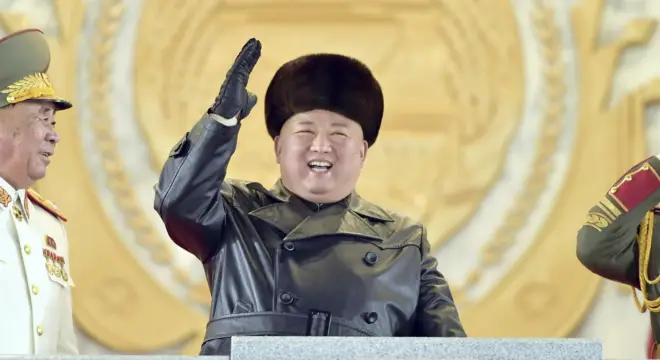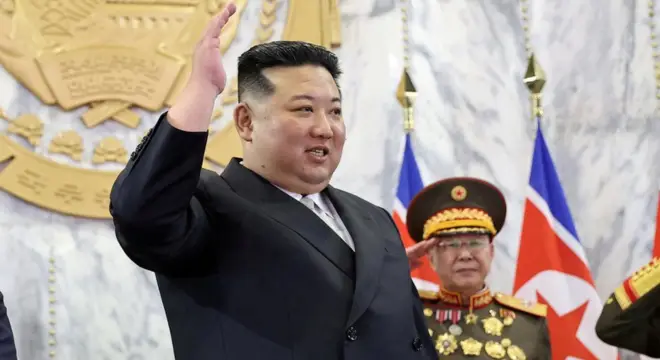What happens when a nation already armed with nuclear weapons decides to strengthen its arsenal further? How should the world interpret Kim Jong Un’s latest pledge to counter the buildup of U.S. forces in South Korea? Could North Korea’s next major military parade become a global showcase of its newest weapons? And most importantly, what does this mean for peace and stability in the Korean Peninsula?
As North Korea prepares for the grand celebration of the 80th anniversary of the ruling Workers’ Party of Korea on October 10, Kim Jong Un has once again shifted the world’s attention to Pyongyang’s growing military ambitions. With talk of “additional military measures” and the possibility of unveiling the next generation of intercontinental ballistic missiles (ICBMs), the upcoming parade may be more than just a ceremonial display—it could serve as a statement of defiance to the U.S., South Korea, and the broader international community.
Let’s explore the details behind Kim’s remarks, the regional tensions driving them, and what to expect in the days ahead.
Kim’s Pledge of “Additional Military Measures”
According to reports from North Korea’s state media KCNA, Kim Jong Un declared that Pyongyang has already allocated strategic assets to respond to the buildup of U.S. forces in South Korea. His statement was made during a military exhibition event in Pyongyang, just days before the highly anticipated anniversary parade.
“In direct proportion to the buildup of U.S. forces in Korea, our strategic interest in the region has also increased, and we have accordingly allocated special assets to key targets of interest,” Kim said, suggesting that North Korea has already positioned weapons systems ready for deployment.
He went on to emphasize that the country will “undoubtedly develop additional military measures” to counter external threats. While he did not elaborate on what these measures would involve, analysts believe that nuclear weapons and advanced missile technologies remain at the heart of Pyongyang’s strategy.

Rising Nuclear Concerns
Recent intelligence assessments from South Korea indicate that North Korea has significantly increased its stockpile of highly enriched and weapons-grade uranium. This development signals a sharp expansion in the regime’s nuclear weapons program, raising concerns across the region.
Kim has repeatedly referred to North Korea’s “nuclear shield and sword”, arguing that only a strong nuclear deterrent can guarantee the nation’s survival against what he sees as American and South Korean aggression. His rhetoric underscores Pyongyang’s long-standing belief that negotiations or peace treaties alone cannot ensure security.
The concern now is not just the number of weapons North Korea may possess, but the sophistication of its delivery systems. With talk of new ICBMs like the rumored Hwasong-20, the stakes have never been higher.
The 80th Anniversary Parade: A Stage for Power
Military parades in Pyongyang are no average occasion. They are tightly scripted showcases of loyalty, strength, and defiance. On October 10, Kim Jong Un is expected to lead a lavish nighttime parade to celebrate the 80th anniversary of the Workers’ Party of Korea.
South Korea’s Yonhap news agency has reported “indications” of mass preparations, including troop movement, vehicles, and assembling tens of thousands of participants. Experts expect North Korea will showcase:
- Next-generation ICBMS (perhaps the Hwasong-20);
- Advanced tactical ballistic missiles;
- The 600mm multiple launch rocket system;
- Other advanced military hardware.
These events have a dual purpose: reinforcing Kim’s hold on the domestic power structure while communicating defiance to the international community.
US-South Korea Tensions at the Core
Kim’s comments occur in the context of the increasing U.S. military presence in South Korea. Joint military exercises, the presence of sophisticated U.S. hardware such as stealth bombers, and the establishment of missile defense systems are all viewed in Pyongyang as threats to its sovereignty.
Kim suggested that any increase in U.S. or South Korean military capacity would be met with equal—or greater—capacity from the North. His words are a direct challenge to Washington’s and Seoul’s defense posture and enhance an already tense security environment.
It is noteworthy that South Korea’s new president, Lee Jae-myung, has promised a more dovish and conciliatory North Korea policy than his predecessor. However, Kim’s rhetoric suggests no relaxation in his stance, and in fact, it seems Pyongyang is increasing its commitment to deterrence.

Aligning with Russia and China
North Korea is not acting alone. In recent years, Pyongyang has moved closer to Russia and China, deepening its military and diplomatic ties. South Korean officials allege that North Korea has been sending troops and artillery to support Russia’s war in Ukraine, a claim that underscores the strategic partnership between Kim Jong Un and Vladimir Putin.
Additionally, Kim recently traveled to Beijing to attend a military parade marking the 80th anniversary of the end of World War II, appearing side by side with Chinese President Xi Jinping and Putin. These public displays highlight a growing trilateral alignment that challenges Western influence in Asia and beyond.
What This Means for the Region
The political situation in the Korean Peninsula has historically been an explosive one, and Kim’s latest remarks make it even more explosive. The October 10 parade potentially showcased advanced missiles to put into the nuclear arsenal, raising concerns that East Asia is slipping into a new arms race.
For South Korea, the problem is balancing its security needs with its new government’s agenda of engagement. For the United States, the problem is the manner in which to deter North Korea without provoking it further. For neighboring countries like Japan and China, the question becomes how Kim’s activities will recast the regional security balance.
Conclusion
The parade on October 10 is not simply a celebration, it will be a global signal of North Korea’s present status and the extent of its military aspirations.
The central question is whether this could remain a display of power or signal the start of new missile tests and nuclear development.
What we do know is that whatever happens in Pyongyang, it will directly affect the regional security environment and potentially steer geopolitics in the near term.


